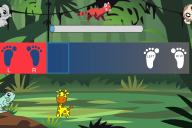“Meaningful improvement in well-being for individuals, be they troubled youths or adults, requires a commitment to gradual change.”
The shifting meaning of gamification
Gamification as a distinctive term first made its appearance in academic papers around 1980. Originally it meant just what it sounded like: Taking a platform or a system that isn’t a proper game and essentially turning it into one [1].
In 2002 a movement called the ‘Serious Games Initiative’ was created to produce simulation games with the expressed desire to teach players a variety of skills that would transfer to the real world. Many of these games were developed for the U.S. Military and could be used as part of training, for instance teaching would-be pilots to operate their planes or would-be soldiers about infantry warfare. A premier example of the latter was America’s Army, a first-person multiplayer shooter game which functioned primarily as an army recruitment tool, released publicly and playable by anyone for free [2].
Gamification today is commonly understood as the practice of introducing certain prominent game elements, like points, scores or progression systems, into a non-entertainment context, thereby increasing user engagement, productivity and learning ability [1]. It is not done to mimic games as ends in themselves. Rather, the goal is to emulate successful engagement techniques which game designers across time have discovered and kept using, across classic board games all the way to modern video games with multi-million dollar budgets.
“It is our view that effective support services must successfully dodge various psychological pitfalls related to their use.”
Gamifying support services
Our common life experiences often appear to validate the following statement: Meaningful improvement in well-being for individuals, be they troubled youths or adults, requires a commitment to gradual change. Likewise it seems uncontroversial to think that even a gradual change demands the introduction and reinforcement of new productive habits, while dismantling existing barriers to personal growth.
Examining gamification in the context of digital support tools should help to devise a more enjoyable application for long term use, regardless of whether the service consists of a practice diary, a conversational assistant, i.e. a chatbot, or some other kind of recommender system. To that end our workshops have devoted time to discuss and evaluate various ways of keeping and rewarding users, especially after the initial novelty of an application has worn off.
It is our view that effective support services must successfully dodge various psychological pitfalls related to their use. For example, in our PEILI project, the workshop discussions with young advisors uncovered several anecdotes of applications that, while generally amiable, managed to earn the ire of their user by engaging them during awkward times of day. This eventually lead to frustration and deletion of the application, suggesting that even relatively small things like the frequency and timing of notifications often carry tremendous weight in user (dis)satisfaction. On the other hand, certain superfluous or ill-conceived elements, like daily login bonuses, have also been a recurring topic of annoyance according to some workshop attendees.
Purely technical features, such as the underlying extent or sophistication of back-end AI techniques, will by contrast go unnoticed and unappreciated by most users. As such they can easily become overvalued by the software engineers in the team who are excited on implement the latest and greatest algorithms, at the expense of tackling simpler, more pressing issues.
Engineering engagement
If our notion holds true, and our young advisors agree, the development team would do well to gather useful feedback about gamification in upcoming workshops. It is crucial that we discover and test promising ways, experienced firsthand and endorsed by our participants, to attract and sustain users in the target demographic.
A failure to appreciate this facet of product development would risk dooming the service to an early grave on account of widespread user apathy and disinterest leading to abandonment of the service. This consideration is doubly important since most (if not all) of the machine learning algorithms we are interested in are hungry for useful data which is gleaned from historical and active use of the service.
In fact, it is practically a given that reaching good performance in the algorithmic back-end part of the service requires some critical mass of users, providing the system with enough information to start gleaning helpful insights that provide value back to individual users. This increasing usefulness should over time translate to newly interested users who end up feeding more new information that again improves the service, forming a virtuous circle.
We shall examine certain algorithmic techniques, associated with our idealized product, and return to this notion of useful data more closely in the next blog which is all about machine learning methods and how they enable us to help future users.
Gamification for the PEILI project
This text is (meant to be) a summary of open discussions around gamification, held in piloting workshops during February of 2019 and comprised of young adults and educational staff, under a project called PEILI (Mirror). As part of this endeavor, my colleagues and I were tasked with developing a useful digital application for helping teens and adults in their trials of building positive personal identities.
It is our conviction, and that of Metropolia UAS, our partner companies, organizations and funders in the European Social Fund, under the EU Commission, that a machine learning application developed for this purpose could improve the rates of education, gainful employment and subjective well-being of youths in contemporary society.
Our team and plan
To achieve our stated goals, we employ a participatory design approach with a team of social and healthcare workers, service design experts, software engineers and potential end users. Our challenge is to incorporate lessons from social and health sciences with recent advances in artificial intelligence, cooperating closely with young adults in target group, who act as our advisors and application testers throughout the development process.
It is hard to overstate the importance of including members from the target group as an integral part of application design and development. In addition to answering questions like ‘What features should the application have’ and ‘How should those features be implemented’, potential end users will help answer fundamental questions as to why a specific feature goal should exist in the first place.
In fact, early workshop discussions have already highlighted the need to shift our focus away from the classroom and workplace into recreational activity. The thinking here is that the lack of educational attainment or successful employment is often a symptom of a deeper issue, one which we need to tackle first in the realm of support connections and social relationships, planting seeds and helping to build a young person’s resilience to future challenges instead of prematurely pushing them towards getting a degree or starting a career.
Sources
- Kevin Werbach, 2019, 1.5 History of Gamification, Gamification Course, Offered by University of Pennsylvania, Coursera, Available online: <https://www.coursera.org/lecture/gamification/1-5-history-of-gamification-7Wp4p>.
- Tom Grant, 2014, US Army, America’s Army Video Game, Serious Games at Work, Available online: <http://www.seriousgamesatwork.org/us-army-americas-army/>.
About the writer
Having completed all of his game development trials at Metropolia University of Applied Sciences, Riku Sykäri is a burgeoning software developer, mixed with an aspiring futurist. He works within Metropolia UAS’s research, development and innovations services as a Software Engineering Assistant in a project called PEILI. Riku has chosen to study machine learning in the hopes of teaching computers to be better with people.










Ei kommentteja